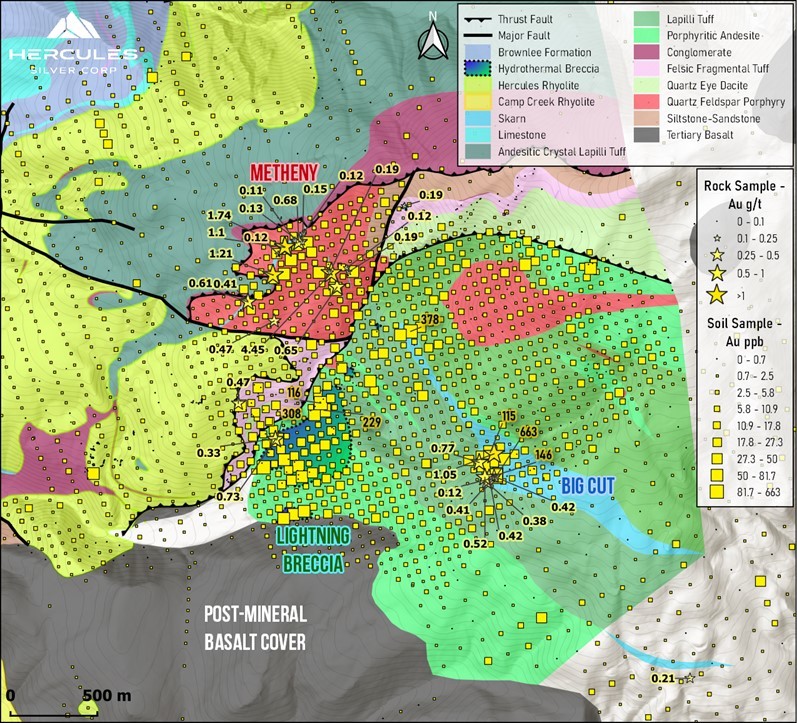Hercules Silver Strengthens New Porphyry Copper/Skarn Target with Gold Grades up
- Select rock chip samples previously reported were fire assayed for gold, returning grades consistent with a porphyry copper/skarn system at the Metheny, Lightning Breccia and Big Cut Zones1
- Supports the thesis of a potential buried porphyry copper (+/- gold) intrusion on the east side of Property, with further evidence including:
- Widespread phyllic and argillic alteration, typically found above a porphyry intrusion, with distal propylitic alteration to the east
- Volcanics and limestones exposed at surface, suggesting the porphyry intrusion lies at depth
- High-grade skarns grading up to 21% copper, 4.5 g/t gold and 1,085 g/t silver (skarn occurs when limestone is altered and mineralized by a nearby porphyry copper intrusion)
- Large hydrothermal breccia pipe (the Lightning Breccia)
- Textbook metal zonation, with a high temperature core of copper-gold (bismuth-tellurium) overlain by silver-lead-zinc (manganese-arsenic-antimony-mercury) in the younger Hercules Rhyolite to the west
- Historical mining tunnel re-discovered at the new South Camp Creek Zone, indicating a potentially significant extension to the CRD-style silver system beyond the 3.5 kilometers of known strike length
Click below for a summary of today’s news from CEO Chris Paul.
Toronto, Ontario–(Newsfile Corp. – April 25, 2023) – Hercules Silver Corp. (TSXV: BIG) (OTCQB: BADEF) (FSE: 8Q7) (“Hercules Silver” or the “Company“) is pleased to announce new gold geochemical results from mineralized skarns and breccias at the Metheny, Big Cut and Lightning Breccia Zones on the Hercules Property located in western Idaho (“Hercules” or the “Property”). On January 24, the Company announced 4-acid assay results for silver, lead, zinc and copper from over 800 rock chip samples within soil anomalies across the Property. A 4-acid digest provides superior analytical results versus a typical aqua regia digest, due to the complete digestion of the sample, however gold values are not reported. The Company subsequently fire assayed select rock samples within the porphyry copper target area, which revealed the presence of gold in bedrock. The gold is associated with mineralized skarns as well as a breccia pipe, both of which are interpreted to be the near-surface expression of a buried porphyry copper target. The new gold-in-rock values are shown along with associated gold-in-soil values in Figure 1.
Figure 1: Gold Grades in Soil and Rock Chip Samples
Higher Grade Potential at Depth
Surface data suggests that the source intrusion responsible for the copper-gold mineralization at surface lies deeper in the system. The geology at surface is typical of the upper levels of a porphyry copper deposit, including phyllic and argillic alteration associated with the copper-gold anomaly, and widespread propylitic alteration outboard of that to the east. This is classic zonation around and above a porphyry copper system, where the higher-grade potassic alteration occurs at depth, below the phyllic and argillic cap.
In the CRD deposit model, the silver-lead-zinc grades increase towards the edge of the porphyry copper intrusion. As a result, the Company may expect to find higher silver-lead-zinc grades at depth, as the rhyolite approaches the buried porphyry copper intrusion (also inferred to lie at depth). This is supported by the presence of a large IP chargeability anomaly at depth in the rhyolite – refer to Hercules Silver’s press release dated December 15, 2022, for additional information. Chargeability is a geophysical technique aimed at measuring the concentration of sulfide mineralization in the ground. The higher chargeability values at depth within the rhyolite suggests an increase in sulfide concentration, which in turn lends itself to potentially increased grades at depth.
Metheny and Big Cut Copper Skarn Zones
Two high-grade copper-silver targets, the Big Cut and Metheny Zones, occur within the Triassic Seven Devils Group on the east side of the Property. Both targets demonstrate skarn-style mineralization which occurs where limestone comes in contact with, or lies within close proximity to, a nearby porphyry intrusion. The Big Cut Zone is classified as a garnet-epidote skarn, whereas the Metheny is a specularite (iron) skarn. The differing alteration is likely a function of zonation around a potential porphyry intrusion or multiple intrusive centers at depth.
Historical trenching at the Big Cut prospect, discussed in unpublished reports obtained by Hercules Silver2,3, yielded grades of up to 1.78% copper across 90 feet (~27 meters) and 1.3% copper across 57 feet (~17 meters). Silver was only selectively assayed at the time and gold was not assayed. Other notable historical trench intercepts at the Big Cut are presented in Table 1…
Read More: Hercules Silver Strengthens New Porphyry Copper/Skarn Target with Gold Grades up


